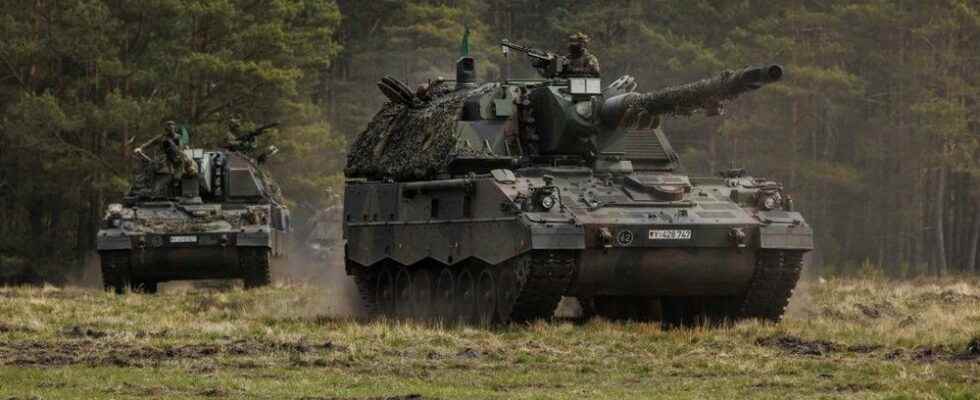To face the Russian steamroller, Ukraine needs heavy weapons more than ever. A point on which its president, Volodymyr Zelensky, could not be clearer. “Only modern artillery will ensure our advantage”, he hammered Monday evening during his daily address, evoking the “terrifying” human cost of the battle of Severodonetsk, at the heart of the fighting in the Donbass. The moment chosen to ring the alarm bell owes nothing to chance. The Contact Group for Ukraine – created by US Secretary of Defense Lloyd Austin and which brings together some forty countries – is due to meet this Wednesday, June 15 in Brussels to study how best to strengthen Ukrainian defense capabilities, on the sidelines of a meeting of NATO Defense Ministers on the same day in the Belgian capital.
As early as June 13, an adviser to the Ukrainian president, Mykhailo Podolyak, had detailed on Twitter the list of armaments so hoped for by kyiv. This includes in particular: “1000 155 mm caliber howitzers, 300 multiple rocket launchers, 500 tanks, 2000 armored vehicles and 1000 drones.” Because for now, the Russian firepower remains overwhelming.
In an interview at Guardian three days earlier, the deputy head of Ukrainian military intelligence, Vadym Skibitsky, had said that Ukraine had only “one artillery piece against 10-15 Russian artillery pieces”. “Our Western partners have given us about 10% of what they have,” he added, believing that Ukraine’s military success would depend above all on new Western arms deliveries.
Not necessarily the same ammunition
Added to this shortage is another difficulty, the heterogeneity of the armaments already sent. Just for the artillery, between the hundred American M777 howitzers, the twelve French Caesar guns, the seven German PZH-2000 howitzers, or the eighteen Polish KRAB howitzers, it is difficult for the Ukrainians to find their way around. “The Ukrainian forces find themselves with a veritable salad of artillery, a sample of a bit of everything, points out Marc Chassillan, military engineer and specialist defense consultant. In total, they received a dozen different artillery guns.”
Two German PZH-2000 howitzers taking part in a NATO exercise, May 10, 2022, near Munster, Germany
Getty Images via AFP
Which, from a logistical point of view, does not facilitate the conduct of operations. “Even if they are of the same caliber, all these guns do not necessarily fire the same shells, confirms General Dominique Trinquand, military expert and former head of the French mission to the UN. Whether for ammunition or parts spare parts, each piece of artillery therefore requires its own logistics chain. If we multiply the number of different pieces of equipment, we de facto complicate the organization of operations.”
Problem: Stretching supply lines further complicates the issue. More than 1,200 kilometers thus separate the Polish border – from where a large quantity of military equipment sent by the West leaves – from the Donbass front. “The delivery of heavy weapons, spare parts and ammunition is a real difficulty for the Ukrainian army, which does not have unlimited payload capacity, notes Vincent Tourret, researcher specializing in military issues at the Foundation for Research (FRS). And the deterioration of the road and rail network after three months of conflict also complicates the equation.”
“Accelerated Wear”
In this context, the question of the maintenance of heavy weapons already supplied to Ukraine could quickly arise. “In this high-intensity war, all Western equipment is used to its maximum capacity, which should result in accelerated wear”, resumes Vincent Tourret. In the absence of Western specialists capable of repairing them near the front line, certain systems will undoubtedly have to be brought back in the event of failure.
Not to mention that each new system also requires training, which is costly in terms of both time and human resources for the Ukrainian forces, whose equipment until now was mainly of Soviet design. Asked on June 8 about the low number of Himars – high-precision multiple rocket launchers – sent to Ukraine, the American Chief of Staff, General Mark Milley indicated that Washington first wanted to ensure that the Ukrainian soldiers were able to use them properly before sending more. So far there are four of them…
At the same time, kyiv signed a $700 million contract with Poland at the end of May for the supply of 60 KRAB howitzers. “It will take time, but little by little Ukraine is also rearming itself, slips Marc Chassillan. This will eventually allow it to obtain equipment much more suitable for war than it leads than the ones we currently deliver.”
